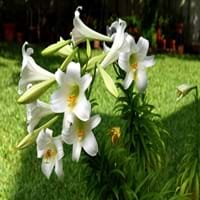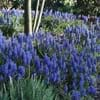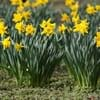Life Span
Perennial
Biennial and Perennial
Type
Bulb or Corm or Tuber
Vegetable
Origin
Japan
Europe, Western Asia
Types
Madonna lily, Turk's cap lily
Not Available
Habitat
Coastal Regions, Temperate Regions, Tropical regions
waste ground, wastelands
USDA Hardiness Zone
6-9
4-9
Sunset Zone
21,22
A1, A2, A3, H1, H2, 1a, 1b, 2a, 2b, 3a, 3b, 4, 5, 6, 7, 8, 9, 10, 11, 12, 13, 14, 15, 16, 17, 18, 19, 20, 21, 22, 23, 24
Habit
Upright/Erect
Rosette/Stemless
Flower Color
White, Light Yellow, Ivory
Yellow
Flower Color Modifier
Bicolor
Bicolor
Fruit Color
Green, Brown
Brown, Black
Leaf Color in Spring
Green, Dark Green
Green
Leaf Color in Summer
Light Green
Green
Leaf Color in Fall
Several shades of Green
Green
Leaf Color in Winter
Light Green
Not Available
Plant Season
Summer
Summer
Sunlight
Full Sun, Partial Sun, Partial shade
Full Sun
Growth Rate
Medium
Medium
Type of Soil
Loam, Sand
Loam
The pH of Soil
Neutral, Alkaline
Neutral
Soil Drainage
Well drained
Well drained
Tolerances
Heat Tolerance, Salt, Shade areas
Drought
Where to Plant?
Container, Ground, Pot
Ground, Pot
How to Plant?
Divison, From bulbs, Seedlings
Seedlings
Plant Maintenance
Medium
Medium
Watering Requirements
Average Water Needs, Do Not over Water, Never Over-water, Requires regular watering
Average Water Needs, Do Not over Water, Keep the ground moist but not water-logged
In Summer
Lots of watering
Lots of watering
In Spring
Ample Water
Moderate
In Winter
Average Water
Average Water
Soil pH
Neutral, Alkaline
Neutral
Soil Type
Loam, Sand
Loam
Soil Drainage Capacity
Well drained
Well drained
Sun Exposure
Full Sun, Partial Sun, Partial shade
Full Sun
Pruning
Prune in winter, Remove dead branches, Remove dead leaves
Remove damaged leaves, Remove dead branches, Remove dead leaves
Fertilizers
All-Purpose Liquid Fertilizer, Water soluble fertilizers
All-Purpose Liquid Fertilizer
Pests and Diseases
Beetles, Red blotch, Sawfly Larvae, Slugs, Snails
Aphids, Armyworm, Cutworms, Downy mildew, Pitch canker, Red blotch
Plant Tolerance
Heat Tolerance, Salt, Shade areas
Drought
Flower Petal Number
Single
Not Available
Fragrant Bark/Stem
No
Yes
Foliage Texture
Medium
Fine
Foliage Sheen
Glossy
Matte
Attracts
Beetles, Flying insects
Butterflies
Allergy
Kidney Disease, Toxic
Stomach burn
Aesthetic Uses
Beautification, Landscape Designing, Showy Purposes
Not Available
Beauty Benefits
Good for skin, Good for skin and hair, Improve hair condition, Improve skin condition
Blood purifying, Good for skin
Environmental Uses
Air purification, Food for insects, Prevent Soil Erosion
Air purification
Medicinal Uses
Not Available
Aphrodisiac
Part of Plant Used
Flowers, Leaves
Root
Other Uses
Decoration Purposes, Showy Purposes, Traditional medicine, Used as Ornamental plant
Food for animals, Used as a nutritious food item
Used As Indoor Plant
Yes
Yes
Used As Outdoor Plant
Yes
Yes
Garden Design
Cutflower, Mixed Border
Edible, Herb, Vegetable
Botanical Name
LILIUM longiflorum
PASTINACA sativa
Common Name
Easter Lily
Parsnip
In Hindi
ईस्टर लिली
चुकंदर
In German
Osterlilie
Pastinake
In French
lis de Pâques
Panais
In Spanish
Lily Pascua
Chirivía
In Greek
Πάσχα Lily
Είδος δαυκίου
In Portuguese
Lily Páscoa
cherivia
In Polish
Easter Lily
Pasternak
Phylum
Embryophyta
Magnoliophyta
Class
Liliopsida
Magnoliopsida
Family
Liliaceae
Apiaceae
Clade
Angiosperms, Monocots
Angiosperms, Asterids, Eudicots
Tribe
Lilieae
Not Available
Subfamily
Lilioideae
Not Available
Number of Species
Not Available
Not Available
Season and Care of Easter Lily and Parsnip
Season and care of Easter Lily and Parsnip is important to know. While considering everything about Easter Lily and Parsnip Care, growing season is an essential factor. Easter Lily season is Summer and Parsnip season is Summer. The type of soil for Easter Lily is Loam, Sand and for Parsnip is Loam while the PH of soil for Easter Lily is Neutral, Alkaline and for Parsnip is Neutral.
Easter Lily and Parsnip Physical Information
Easter Lily and Parsnip physical information is very important for comparison. Easter Lily height is 45.70 cm and width 30.00 cm whereas Parsnip height is 15.20 cm and width 7.60 cm. The color specification of Easter Lily and Parsnip are as follows:
Easter Lily flower color: White, Light Yellow and Ivory
Easter Lily leaf color: Green and Dark Green
Parsnip flower color: Yellow
- Parsnip leaf color: Green
Care of Easter Lily and Parsnip
Care of Easter Lily and Parsnip include pruning, fertilizers, watering etc. Easter Lily pruning is done Prune in winter, Remove dead branches and Remove dead leaves and Parsnip pruning is done Remove damaged leaves, Remove dead branches and Remove dead leaves. In summer Easter Lily needs Lots of watering and in winter, it needs Average Water. Whereas, in summer Parsnip needs Lots of watering and in winter, it needs Average Water.





